How Salesforce Built a $13 Billion Empire from a CRM

当中国企业还在犹豫上不上云,To B的大客户销售还在绞尽脑汁,构思话术来为客户排解顾虑,SaaS领域的的头把交椅Salesforce已经快要迎接20岁的生日了。
Salesforce可以说是所有SaaS公司的先行者。创建于1999年的Salesforce重新定义了CRM市场。Salesforce特立独行,高举“No Software” 大旗,是个彻彻底底的颠覆者。
从云CRM工具起步,Salesforce快速成长为一家市值数百亿美元的SaaS巨无霸,目前已成为全球按需CRM解决方案的领导者。Salesforce取得的巨大成功开创了一个全新的时代,成功带领企业软件进入一种新的商业模式时代:软件通过互联网和订阅租赁的方式提供给用户使用。
Salesforce是如何取得今天的成绩的?未来的Salesforce将走向何方?我们能从它的发展经历中吸取哪些经验?本文将为你一一揭秘。
2000年,Marc Benioff发起了硅谷有史以来第一次戏剧性的抗议活动。
In 2000, Marc Benioff staged the first theatrical protest that Silicon Valley had ever seen.

The CEO of a tiny startup that no one had heard of paid actors to carry “anti-software” signs. They marched in front of a user conference for Siebel Systems, which sold customer relationship management software. Later that year, Benioff hosted a military-themed party where guests threw “pieces of software” into trash bins.
这位名不见经传的小创业公司的CEO雇佣了一批演员,让他们举着印有“No Software”的标识牌子在Siebel Systems公司举行的用户大会的场地附近游行,Siebel Systems公司做的是客户关系管理软件。同年晚些时候,Benioff举办了一个以军事为主题的聚会,在聚会上,客人们把一些软件的碎片扔进垃圾箱。
Benioff的这些噱头成功地引起了人们的注意,但没有人真正相信Benioff的初创公司Salesforce有能力与大型软件公司PK。Business Insider当时还专门写了一篇关于Benioff发起的抗议活动的文章,将Salesforce描述为“野餐中的蚂蚁”。
The stunts gained attention, but no one really believed that Benioff’s startup Salesforce could take on giant software companies. Business Insider wrote an article on the protest and called Salesforce “the ant at the picnic.”
如今,被称为“野餐中的蚂蚁”的Salesforce已经创造了2500亿美元的全球市场。Benioff的Salesforce是建立在这个理念上的:软件应该能够通过云端7×24小时 为用户提供服务。Salesforce是第一家这样做的公司。在20世纪90年代末,甲骨文和SAP等公司向企业客户销售的软件件需要进行本地安装和更新。如今,甲骨文、SAP和其他很多公司都开始跟风开发云产品,试图抓住Salesforce发起的运动。
The ant at the picnic has helped to create a $250 billion global market. Benioff’s company was built around one main idea: that software should be delivered 24/7 to people over the cloud. Salesforce was the first company to do this. In the late 1990s, companies like Oracle and SAP were selling software to businesses that had to be installed and updated on-premise. Now, Oracle, SAP, and the rest of the world are belatedly building cloud products, trying to catch on to the movement that Salesforce started.
Salesforce自诩自己开发的CRM工具是世界上第一款云产品,并积极宣传公司的愿景。他们围绕一个相对简单的产品向用户兜售云的概念,然后,他们开始开发其它产品,并寻找培育一个不断增长的生态系统的方法,最理想的情况是能驱动Salesforce的营收增长。现在,Salesforce通过打造更多的用例并改进自己产品的方式来直接应对竞争对手的竞争,从而捍卫自己现在的地位。
Salesforce staked a claim by building one of the first cloud products, a CRM tool, and aggressively evangelizing the company’s vision. They sold users on the idea of the cloud around a relatively straightforward product. Then they started building out other products and looking for ways to nurture a growing ecosystem—ideally to drive revenue back to Salesforce. Now, they’re defending their position as an incumbent by building more use cases and improving their own products in direct response to competitors.
为了更好地了解Salesforce的诞生和崛起,我们需要回答下面这些问题:
1. Salesforce是如何通过一种没人听说过的方式来成功颠覆现有的、基于本地部署的软件提供商的市场的?
2. 在如今竞争对手云集的行业里,Salesforce是如何保持住这样的成功,并能够持续增加营收并在产品上不断创新的?
3. Salesforce如何既能够做到持续增长和创新、同时保持其品牌的连续性的?
下面就让我们更深入地了解一下这个具有开创性的SaaS巨头是如何诞生的,以及它未来的发展方向。
This unique entrance and growth in the software industry prompts a few questions:
* How did Salesforce so successfully disrupt the market of incumbent, on-premise software providers with a model no one had heard of before?
* How has Salesforce remained so successful and continued to grow revenue and innovate on their products in an industry that is now crowded with competitors?
* How can Salesforce continue to grow and innovate while maintaining continuity with their brand?
Let’s take a deeper look at how the original SaaS behemoth got its start, and where it can go moving forward.
1999-2004: Making it easier for people to use software
1999-2004:让用户能够更容易地使用软件
Salesforce的将所有软件都带到云端的愿景是具有革命性的。但是你无法一下子就树立这样一个愿景,在过去18年时间里,Salesforce一直在努力将这个愿景变成现实。刚开始的时候,云的概念是抽象的和笨拙的。为了真正树立他们的愿景,他们必须从一款产品开始做起。
Salesforce’s vision to bring all software to the cloud was revolutionary. But you can’t build a vision in one fell swoop—Salesforce has been bringing their vision to life over the past 18 years. At the beginning, the concept of the cloud was abstract and unwieldy. To actually build their vision, they had to start with just one product.
在20世纪90年代末,客户关系管理软件行业热闹非凡。像甲骨文和SAP这样的大企业之间的竞争鼓励更多的企业在自己的产品中添加越来越多的功能和特性,使得他们的产品变得非常笨重而复杂。但是企业客户仍在使用它们,因为它们需要一个集中系统来跟踪销售和客户数据。
In the late 1990s, there was a lot of activity in the customer relationship management software industry. Competition between big enterprise companies, like Oracle and SAP, was encouraging companies to add more and more features and offerings to their products, making them bulky and complex. But companies still used them because they needed a centralized system to keep track of sales and customer data.
Salesforce的几位联合创始人都曾有过在CRM和销售团队自动化产品方面的工作经验。Salesforce开始着手开发一款比市场上那些笨重的产品更加简单易用的产品。很快,他们的产品就开发完成了,而且能很容易地与现有的系统进行集成,能方便地按用户数付费,而且产品总是运行得很快。
The co-founders of Salesforce all had experience working on CRMs and sales force automation. Salesforce set out to make a product that was simpler and easier to use than the bulky products that were available. Theirs would be quick to set up, integrated easily with existing systems, easy to pay for per user, and would always run fast.
早期的产品开发和市场营销工作都是围绕一个简单的想法为来开展的:让CRM软件更容易使用。下面是Salesforce将这个简单的想法变成现实的时间表:
Early product development and marketing centered around a simple idea: making CRM software easier to use. Here’s a timeline of how the company brought that simple idea to life:
1999:Salesforce的联合创始人 Marc Benioff从数据库公司甲骨文的副总裁的职位上离职。1986年,刚大学毕业的Benioff加入了当时世界最大的企业软件公司甲骨文,成为公司的前200名员工之一。你可能不知道的是,他在甲骨文的第一个工作是电话客服,主要负责接听公司的800热线电话。
但他很快爱上了这个职业,发现同客户打交道很有意思,而且与编程相比,自己更擅长与人打交道。出于对苹果的热爱,他总是找各种机会向老板Larry Ellison兜售自己开拓苹果市场的计划,并很快被后者提升为甲骨文Mac部门的主管。年仅23岁,他就被授予Oracle最佳新秀的荣誉。
3年后,Marc又晋升为副总裁,也是当时公司最年轻的副总裁。在甲骨文多年的工作经历让Benioff对企业软件有了深刻的理解,并且对传统企业软件的定论 “拥有才能控制” 有了不同的想法,这也是他后来创办Salesforce的主要原因之一。
Salesforce 联合创始人马克-贝尼奥夫(Marc Benioff)从甲骨文公司(Oracle)数据库副总裁的职位上离职,此前他在客户支持部门工作了 13 年。在此期间,他与甲骨文创始人拉里-埃里森(Larry Ellison)建立了密切的工作关系。同时,他也对如何改进客户关系管理软件和一般软件形成了自己的想法:
1999: Salesforce co-founder Marc Benioff left his role as Vice President of database company Oracle after working his way up from customer support over the course of 13 years. In that time, he’d developed a close working relationship with Oracle founder Larry Ellison. He’d also formed ideas about how CRM software—and software in general—could be improved:
“这种(云交付)模式使软件类似于公用事业,就像每月支付电费一样。为什么客户不能为一项随时随地运行业务应用的服务按月付费呢?- 马克-贝尼奥夫
“This [cloud delivery] model made software similar to a utility, akin to paying a monthly electric bill. Why couldn’t customers pay a monthly bill for a service that would run business applications whenever and wherever?” – Marc Benioff
在甲骨文的时候,Benioff就开始做一些风险投资,并从投资的一些项目中获得了丰厚的回报。因此他对创业这件事是有一些了解的。
1999年,Benioff放弃了在甲骨文稳定的工作和优厚的待遇,毅然决然地离职创办了Salesforce。很多今天在职场如鱼得水的人们虽然也有创业的想法,但是可能永远也不会行动。
对于Benioff的这一决定,前老板Larry Ellison也非常支持,除了给他200万美元作为天使投资外,Larry 还允许Benioff上午在Salesforce工作,下午来甲骨文上班,还承诺如果日后Salesforce经营不善,Marc还可以重回甲骨文。
当Benioff离开甲骨文时,他从一家他投资过的创业公司里招聘了三名咨询顾问,与他合作打造一个更好的CRM工具,这三名咨询顾问分别是Parker Harris、Dave Moellenhoff和Frank Dominguez。因为他们以前曾一起工作过,因此形成了良好的关系,有些人之前甚至还参与过非SaaS模式的CRM产品的开发。 从一开始,这个团队的技术实力就非常强,并且拥有一个一致的宏大愿景。他们一起开发完成了Salesforce CRM产品的第一个版本。最初的产品版本是下面这样的:
When Benioff left Oracle, he recruited three consultants from a startup he had invested in to work with him on “a better CRM”: Parker Harris, Dave Moellenhoff, and Frank Dominguez. They’d all worked together before and formed good relationships, and some had even worked on non-SaaS CRM products. From the beginning, the team was very technically capable and aligned on a higher-level vision. Together they created the first version of Salesforce’s CRM. It looked like this:

2000-2002:针对开发出的CRM工具,Salesforce发起了一项积极的、进攻型的营销活动。首先就是那场在Siebel Systems用户大会前的游行抗议活动和以“No Software”为主题的大Party。在Salesforce创立之初,Benioff就敢于跟行业内的一些巨头叫板,直接将Salesforce描述为一个可以替代微软、Siebel、甲骨文和SAP的另一个选择。
将自己羽翼未丰的小公司与那些行业巨头相提并论,Marc的这种做法成功吸引了众多媒体和分析师的注意,他们开始纷纷报道Salesforce是如何挑战传统软件巨头的,Salesforce显然处于弱势,但Marc充分利用每一个机会去抢竞争对手的风头。
最开始做市场活动时,Benioff所秉承的法则是:如果你是一个小公司,那么你要拼命地打击你的最大的竞争对手,如果你已经是这个市场的领导者了,那么不要在意任何竞争对手对你的挑衅,不要回应。优秀的领导者在市场行为上总是善于创新,而平庸的选手只能跟随。如果你认为Marc的做法值得借鉴的话,那不妨试试。
Salesforce早期还举办过一场名为“软件终结者”的广告活动,广告宣传画中描绘的是一亮灵活的战斗机击落一亮红色双翼飞机,暗示Salesforce终将打败甲骨文。Benioff还专门请广告专家为公司设计了 “no software” 的 logo,并将 Logo印在所有能印的素材上,还要求员工和他一样每天佩戴 “no software” 徽章。
在这个过程中,Benioff与媒体建立了非常好的关系。因此对于如何利用媒体为自己服务这个问题,Benioff可谓颇有心得。在他看来,你要做的就是有选择性地结交媒体记者,同时要创造能够代表自己的词汇,并向媒体记者讲述。对Salesforce而言,no software就是它创造出来的能代表自己理念的全新词汇。通过一系列出色的品牌与市场活动,Benioff成功宣传了Salesforce的的定位(SaaS和SFA行业的先行者)和理念(no software),慢慢让Salesforce占领用户的心智。
2000-2002: Salesforce launched an aggressive marketing strategy around their CRM. It started with the Siebel protests and the “End of Software” party. According to their “anti-software” marketing message, software (or the incumbent, on-premise software) was making life more difficult for salespeople working in CRMs. The messaging on the Salesforce website at the time showed how focused the team was on better product, quicker set-up, and more accessibility.
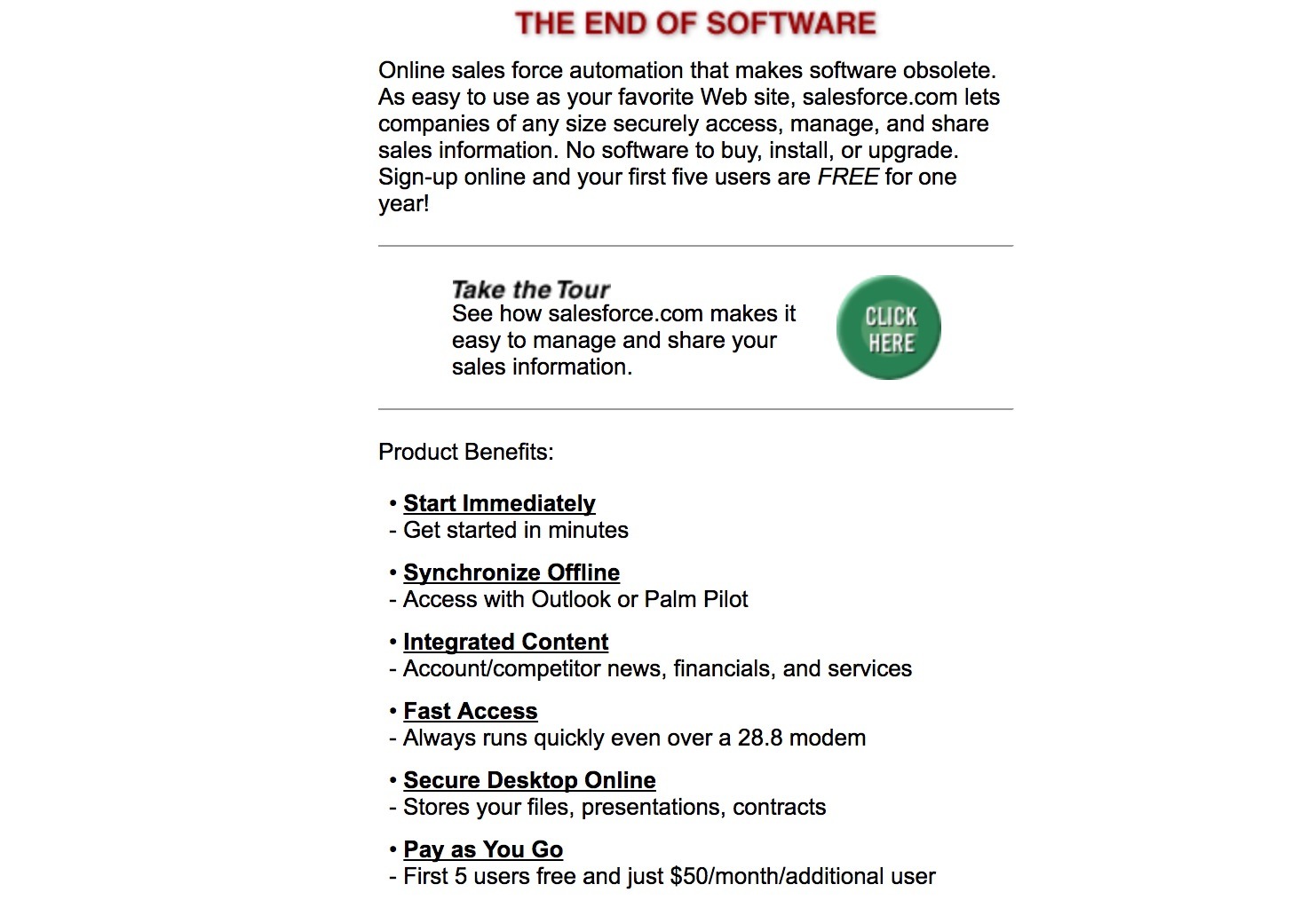
[ A product description from the Salesforce website in 2000. Source: Web Archive ]
(▲ 2000年时Salesforce官网的产品描述)
根据Salesforce的“抵制Software"的营销文案,对于使用CRM工作的销售人员来说,软件(或者传统的本地部署的软件)正在使他们的工作变得更困难。当时Salesforce官网上的文案显示该团队对于更好的产品、更快的设置和更高的可访问性的重视。
在Salesforce.com创立两年之后,Marc第一次统计了他们的市场行为的投入产出比,结果令他震惊了:烧了那么多的钱,只获得14个潜在客户。市场活动成功地打出了品牌,制造了轰动效应,但转化效果却并不理想,Salesforce开始对市场战略进行调整。
Marc发现,转化率最高的市场营销方式有两种:一种是新闻媒体无偏见的商业和科技报道;另一种是客户间的分享推荐所带来的口碑效应。为了让自己的产品在客户间形成口碑传播,Salesforce探索出了一种非常有效的方法,就是把现有客户和潜在客户放在一起交流。交流的方式多种多样,有城市巡回活动,选择高大上的场所营造高档次的体验;也有鸡尾酒party形式,包括主题发言和客户分享等环节。
客户间的口碑传播对Salesforce帮助很大,只要你能让客户通过使用你的产品获得成功,客户便会成为品牌粉丝,主动传播和推荐你的产品。懂客户,就是懂得与客户共性共荣的道理。
在Salesforce正发展得顺风顺水之时,一场危机正在慢慢降临。2001年,互联网泡沫破裂。大部分互联网公司都开始出现资金不足的问题,很多公司濒临倒闭。
在2001年11月份的时候,Salesforce每月要亏损100-150万美元,出现了严重的现金流问题,风险投资机构也不愿在这个时候拿钱出来。濒临破产边缘的Salesforce想到了一个方法:与客户按照年签订合同,而且需要提前付费。 如果客户同意按年签订合同并付费的方案,就可以享受到非常有力度的折扣。
Salesforce的这个决定也成为公司营收增长的一个非常重要的转折点。这种模式也极大提高了销售人员的积极性,因为客户按年提前付费可以让销售立刻拿到销售佣金。
2003:Salesforce通过自己的实际行动表明,为了宣传自己的产品并打造一个自己的用户社区,他们愿意尝试那些具有争议性的宣传活动。为了庆祝自己获得了10万用户,他们向外界发布了一份邀请函,邀请函中印有达赖喇嘛的照片。这一举动受到了外界的强烈批评,Benioff被迫为此事道歉。
2003: Salesforce showed that they were willing to make controversial moves to evangelize their product and develop a community. They released an invitation for a celebration of 100,000 Salesforce users that featured the Dalai Lama. It was received with intense criticism and Benioff was forced to apologize.

[ An invitation to a Salesforce event featuring the phrase “There is no software on the path to Enlightenment.” Source: ahrefs.blog ]
(▲Salesforce为一次活动设计的邀请函,邀请函上印有这句话:“在通往觉悟启蒙的道路上是没有软件的”。)
The same year, the company also held its first annual Dreamforce user conference. They started a tradition of announcing new products and ideas at the conference each year. This was the next step in formally building out a Salesforce community and creating enthusiasm around the cloud.
也是在这一年,Salesforce举办了首届Dreamforce用户大会。从那之后,Salesforce就形成了一个传统,就是每年都在Dreamforce用户大会上发布自己的新产品。这是Salesforce用来打造自己的用户社区并激发大家对云计算领域激情的第二个步骤。
2004:这一年,Salesforce成功IPO。在IPO首日,公司股价上涨超过55%,公司也成为新闻热点。成功的IPO进一步证明了Salesforce已经打造出了人们喜爱的产品,公司也在互联网泡沫破裂后一直存活了下来并实现了持续增长,同时成功地向大家兜售了公司关于云服务的愿景。
2004: Salesforce announced their IPO. On the first day of trading, the company made headlines as their stock gained over 55% appreciation. The successful IPO was a testament to how Salesforce had built a product people loved, survived the dot-com bubble bursting, continued growing, and successfully started selling people on their vision for the cloud.
在这些年里,Salesforce是通过始终确保产品、营销和销售拥有紧密一致的策略的方式来实现增长。尽管云产品对用户来说是一个全新的概念,但是它的价值定位能够很容易得到目标用户和销售人员的支持,这个价值定位就是:一款更好的CRM。
In these years Salesforce grew by keeping their product, marketing, and sales strategies tightly aligned. Though the idea of a product in the cloud was completely new to users, the value proposition was one that their target audience, salespeople, could easily get behind: a better CRM.
这正是Salesforce努力践行的。尽管公司团队知道他们的早期产品是“简单到只剩骨架的”,但这正是客户所需要的。因为和Siebel和SAP那些复杂的、经常出问题的CRM产品相比,Salesforce的工具是非常流畅和简单的。
That’s exactly what Salesforce delivered on. Though the team believed their early product was “bare bones to a fault,” that’s exactly what customers were looking for. Compared to the complicated and buggy CRMs of Siebel and SAP, Salesforce’s tool was streamlined and simple.
这些早期的用户是销售人员,而不是公司里的其他岗位人员,这一点是决定Salesforce营销策略的关键因素。在大部分公司里,销售人员都是一个营收来源中心,销售团队通常更愿意投资那些能够帮他们更高效地达成营收目标的新技术和新工具。因此,Salesforce可以直接向用户展示自己的产品是如何能够帮助他们的公司赚更多钱的。
That these early users were salespeople—and not any other role in the customers’ companies—was a critical part of Salesforce’s marketing strategy. For most companies, sales is a revenue center—and sales teams are often willing to invest in new tech if it means reaching their revenue goals more effectively. As a result, Salesforce could directly show how its product helped a company make more money.
Salesforce实际上发明了免费试用和销售软件的新模式。公司的产品是通过云端提供的的软件即服务(SaaS)产品,这在早期用户群中打造了一个强大的病毒式分发传播渠道。由于这款产品不需要任何设置,所以从技术上讲,Salesforce是可以免费提供这款工具的。因此,他们制定了一个计划,让任何一家公司的前五名用户都可以免费使用自己的CRM工具。
Salesforce essentially invented the free trail and a new model for selling software. The product was a software-as-a-service product delivered over the cloud, which created a powerful viral distribution channel among these early users. Since the product didn’t require any setup, it was technically possible for Salesforce to offer the tool for free. So they created a plan where the first five users at any company could use the CRM free of charge.
一旦一个团队成员试用过并喜欢上这款产品之后,这时让更多团队成员使用这款产品将会变得非常容易,这主要得益于Salesforce的简单定价计划。他们可以通过终端用户数或升级更多功能的方式来进行扩张。为客户提供两种新购扩张方式帮助Salesforce的营收实现了几何式增长。
Once a team member tried it and liked it, scaling up the team was easy thanks to Salesforce’s straightforward pricing plan. They could scale up by seat or by upgrading to more functionality. Giving customers two ways to expand also helped fuel geometric revenue growth for Salesforce.
在一个接受度很高的市场里销售一款自带病毒式传播模式的易于使用的产品,这帮助Salesforce实现了非常高的资本效率。这让公司能够将营收重新投资在增长引擎上。
Selling an easy-to-use product with a viral distribution model to an amenable market helped Salesforce achieve high capital efficiency. This allowed the company to keep investing back into their growth engine.
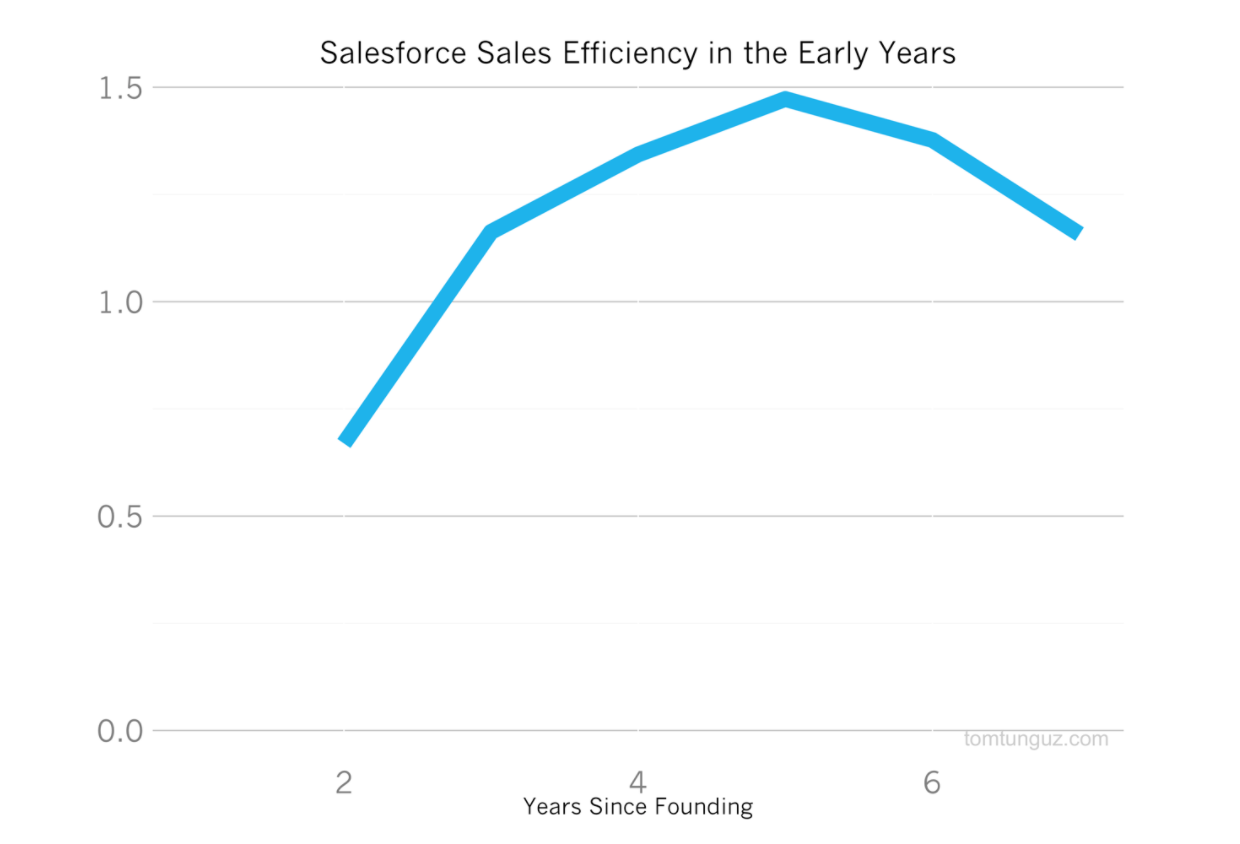
[ From 2002 to 2006, Salesforce’s sales efficiency metric was >1, meaning the company made $1 or more on every dollar of sales and marketing than they spent. Source: Tom Tunguz ]
(▲从2002年到2006年,Salesforce的销售效率指标是大于1的,这意味着公司在销售和营销上花的每一美元带来的收入都比他们的开支要多1美元甚至更多)
这些销售和营销活动也刺激了公司业务的高速增长。2001-2003年,公司的年均复合增长率超过100%。得益于用户友好型产品与病毒式分销传播渠道的完美结合,公司营收从2001年的590万美元增长至2003年的5090万美元。在2004年 IPO中,Salesforce的ARR(年经常性营收)达到了9600万美元,公司估值为11亿美元。
These sales and marketing practices also fueled unusually high revenue growth. The company had over 100% compounded annual growth rate from 2001-2003.
The combination of a user-friendly product and a viral distribution channel helped the company to grow from $5.9 million in revenue in 2001 to $50.9 million in 2003, when they filed for IPO. During their 2004 IPO, the company was doing $96 million in ARR, and was valued at $1.1 billion.
Salesforce最开始将自己定位为传统CRM软件的颠覆者,但是公司依然将云端CRM作为自己的主要产品。但Benioff的愿景比CRM要大得多。
Salesforce was establishing the company as a CRM disruptor in the cloud—and still relied on their CRM as the main product. But Benioff’s vision was much bigger than a CRM.
2005-2014:从软件扩展至平台即服务(PaaS)平台
2005-2014: Scaling up into a platform-as-a-service
当Salesforce刚开始在云端销售CRM产品的时候,他们当时是第一家也是唯一一家SaaS公司。他们的竞争对手是现有的、基于本地部署的CRM软件。但是随着公司的发展,这种情况慢慢发生了变化。
When Salesforce started selling a CRM in the cloud, they were the first and only SaaS company. Their competition was the incumbent, on-premise CRM software. But this changed as the company grew.
Salesforce早期的成功预示着将会有更多新兴的云业务公司的崛起。很多公司发现这种云端交付模式能够让自己更快地为更多用户打造和分发产品。
Salesforce’s early success heralded the rise of many new cloud businesses. Companies saw that this delivery model allowed them to build and distribute products to more users, faster.
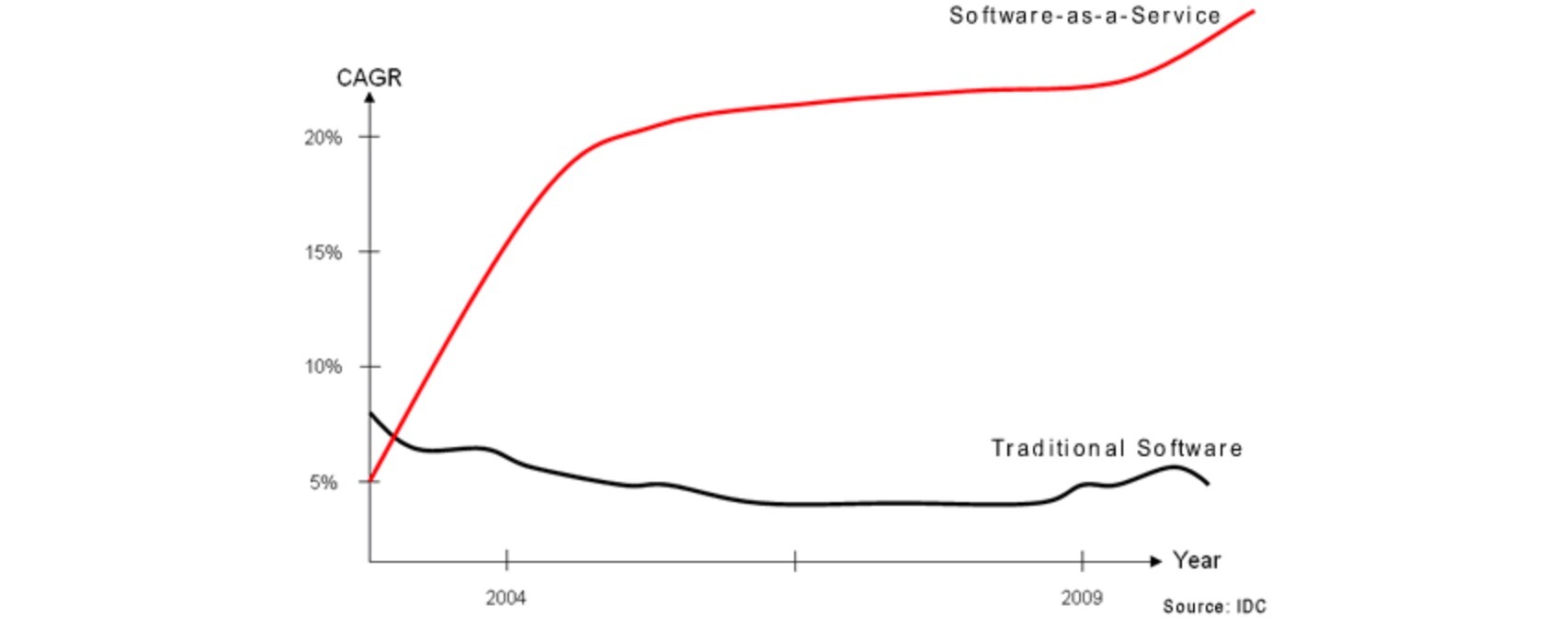
在Salesforce 2004年IPO之后,SaaS行业的复合年均增长率达到15%左右,达到历史新高,而且还会继续增长。与此同时,传统软件的复合年均增长率仅为5%,而且还在继续下降。
After Salesforce’s IPO in 2004, the compounded annual growth rate of the SaaS industry was at a historical high around 15%, and would only continue growing. Meanwhile, the CAGR of traditional software was around 5% and dropping. Source: CRM Landmark
Salesforce并没有对这些新兴的SaaS公司采取敌对态度,而是选择向前一步拥抱这些SaaS公司的态度。Salesforce搭建了一个平台,开发者可以基于Salesforce开发定制应用,同时还打造了一个核心社区,在这个社区里,Salesforce用户可以开发和销售他们自己开发的应用。
Instead of adopting a hostile attitude toward these new SaaS companies, Salesforce leaned in. They built a platform where developers could build custom applications on top of Salesforce, and created a central community where Salesforce users could build and sell their apps. They also started expanding their core offerings beyond a CRM by acquiring other SaaS companies and repurposing them within their own suite of products.
Salesforce还收购了其他很多SaaS公司,并在自己的产品组合中对收购的产品进行重新定位,从而将自己的核心产品扩展到CRM之外的其它领域。通过提供更多的云产品,比如客服支持工具和协作工具,Salesforce撒下了一张更大的网,从而将更多的用户带到Salesforce的平台上。
通过让开发者基于自己的平台进行开发,这反过来又增加了Salesforce产品的价值,使得Salesforce的生态系统更具吸引力。
通过扩展提供更多的云产品(如支持和协作工具),他们撒下了更大的网,将用户引入 Salesforce。这使得生态系统对开发人员更具吸引力,从而提高了 Salesforce 产品的价值。云的发展越快,Salesforce 的发展也就越快。
By expanding to offer more cloud products—like support and collaboration tools—they cast a wider net to bring users into Salesforce. That made the ecosystem more attractive for developers to build on, which in turn increased the value of Salesforce’s offerings. The more the cloud grew, the more Salesforce grew.
2005:Salesforce发布了AppExchange。在这个平台上,第三方开发者可以创建自己的应用,并将应用销售给Salesforce用户社区里的其它成员。
2005: Salesforce built the AppExchange. Here, third-party developers could create their own apps and sell them to a community of other Salesforce users.
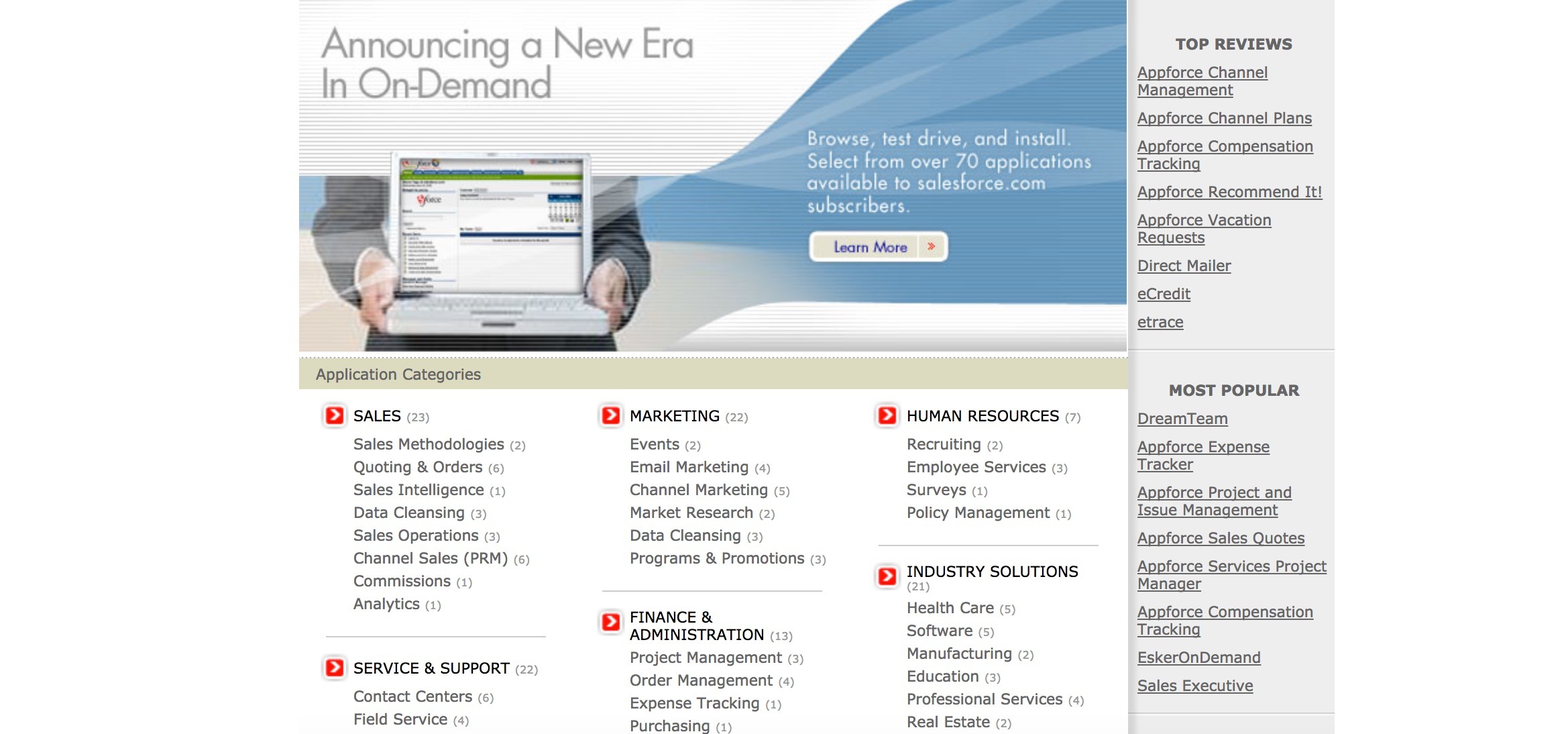
The AppExchange page in 2005. Source: Web Archive
(▲2005年AppExchange的网站页面)
这是Salesforce用来培育云计算行业的下一个合乎逻辑的步骤,因为它为开发者提供了一个支持性社区和目标用户群体。
This was the next logical step in nurturing a growing cloud computing industry, because it gave developers a supportive community and audience.
2006:Salesforce团队发布了Apex,这是一种按需编程语言,允许第三方程序员在Salesforce的多租户、共享架构上编写和运行代码。Salesforce合伙人Parker Harris还打造了Visualforce,它允许用户创建自己想要的任何用户界面,并创建表单、按钮、链接和嵌入任何东西。
2006: The Salesforce team laid more bricks by releasing Apex, an on-demand programming language that allowed third-party programmers to write and run code on Salesforce’s multi-tenant, shared architecture. Parker Harris also created Visualforce, which allowed users to create any user interface they wanted and build forms, buttons, links, and embed anything.
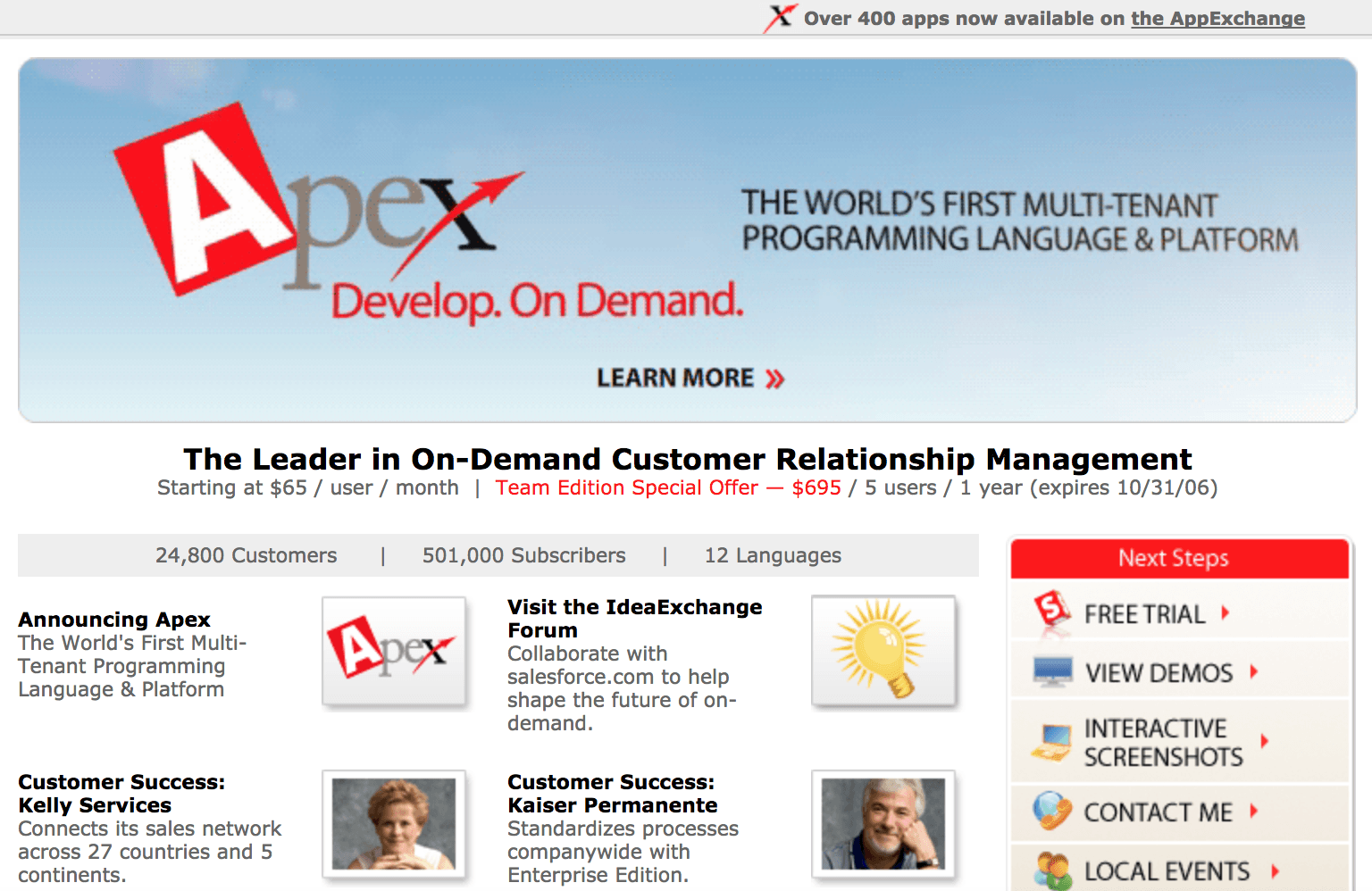
From a 2006 version of the Salesforce homepage. Source: Web Archive
(▲Salesforce 2006年的官网页面)
2008:Salesforce发布了一个面向开发者的官方平台:Force.com。这也是世界上第一个平台即服务(PaaS)产品。它允许第三方在Salesforce的架构上部署应用。它还为Salesforce创造了一个新的营收渠道,因为第三方需要付费才能使用这个平台。
2008: Salesforce released an official platform for developers, Force.com. This was the world’s first platform-as-a-service. It allowed third parties to deploy apps on Salesforce’s architecture. It also created a new revenue stream for Salesforce, as third parties paid per login to use the platform.
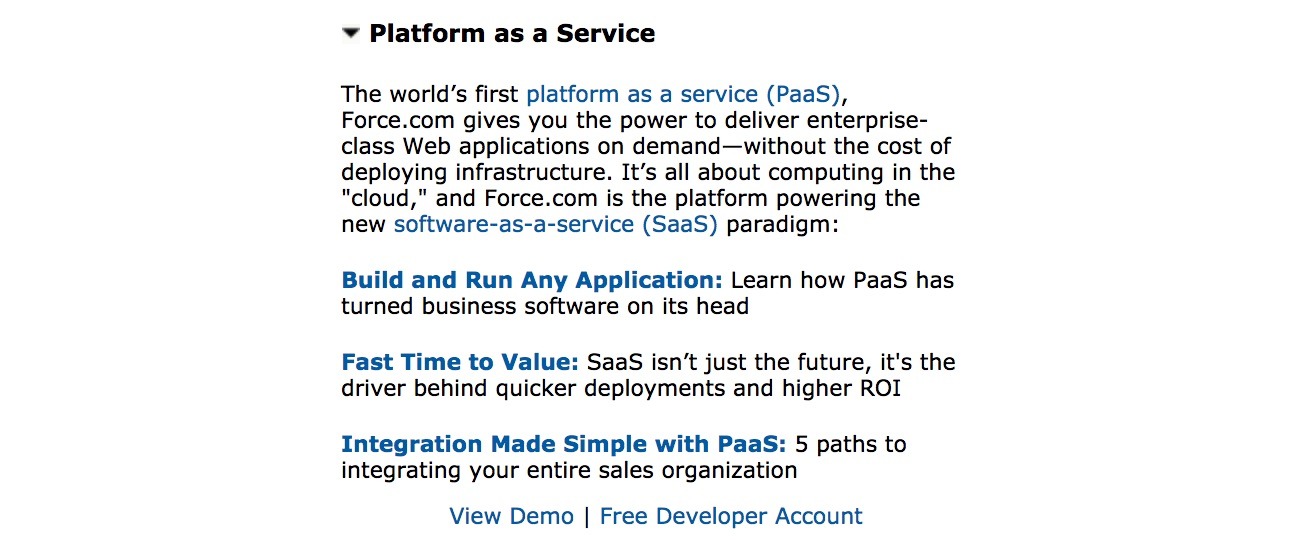
From a 2008 version of the Salesforce homepage. Source: Web Archive
(▲Salesforce 2008年时的官网页面)
2011:Salesforce将收购的众包数据公司Jigsaw进行了重新定位并更名为Data.com。类似这样的收购帮助Salesforce扩展了在SaaS行业的业务范围,并在这个过程中增加了营收渠道。
2011: Salesforce repurposed the acquired crowd-sourced data company Jigsaw as Data.com. Acquisitions like these helped Salesforce extend their reach in the SaaS industry with different arms, adding new revenue centers along the way.
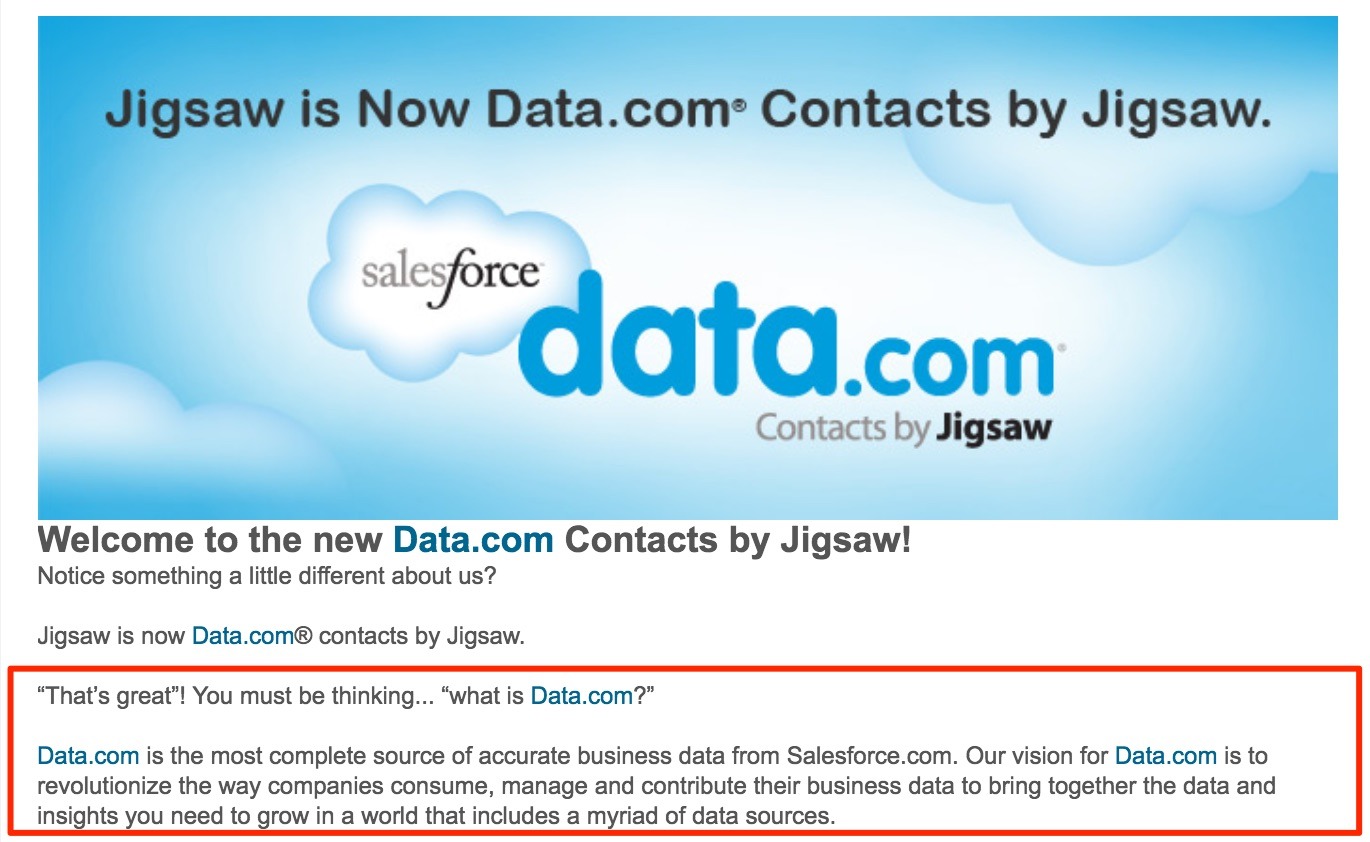
Data.com announcement in 2011. Source: Data.com
(▲2011年,Salesforce发布的Jigsaw更名为Data.com的通知)
2012:Salesforce对收购的社交客户服务工具Assistly进行了重新定位并将其更名为Desk.com。Salesforce在Assistly发展早期就对其进行了投资,并最终在2011年以8000万美元的价格将其收购。这次收购帮助Salesforce将Desk.com变成了一个社交帮助平台。Desk.com允许小企业在Twitter和Facebook等社交媒体上提供客户服务,并包含12种报告模式,提供平均处理时间和第一响应时间等数据。这款工具还可以利用Salesforce CRM的数据,从而为客户提供更完整的体验。这个新产品继续增加了公司的产品用例,同时也为公司新增了一个营收渠道。
2012: Salesforce repurposed the acquired social customer service tool Assistly as Desk.com. Salesforce had made an earlier investment in the startup, and finally bought it in 2011 for $80 million. The acquisition helped Salesforce turn Desk.com into a social help desk. The tool could draw on data from the Salesforce CRM to provide a more integrated experience for customers. This new product offering continued to expand their products’ use cases, and the company’s revenue centers.
2013:Salesforce将收购后的社交媒体监测平台Radian 6更名为Social.com,让客户能够将社交媒体数据和CRM数据整合在一起。公司还持续在营销云业务上扩充他们的产品。
2013: Salesforce repurposed the acquired social media monitoring platform Radian 6 as Social.com to allow customers to integrate social media data and CRM data. The company continued to expand their offerings on their Marketing Cloud.
2013年,在Salesforce的AppExchange平台上,下载和安装应用总数达到200万,达到了一个新的里程碑。这进一步证明Salesforce作为平台提供商也是可以取得增长和成功,而不仅仅是作为CRM提供商。
That same year, Salesforce hit a milestone with 2 million apps downloaded and installed on the AppExchange. This demonstrated the success and growth of the company as a platform provider, not just a CRM provider.
过去几年时间里,围绕CRM的早期营销已经开始让人们对云充满了热情,Salesforce也开始开发其他云产品。现在,Salesforce不仅仅在围绕CRM来兜售自己有关云的愿景。它也开始向其他开发者推广这一愿景,让开发者知道他们是可以基于Salesforce的PaaS平台来开发云应用的。与此同时,Salesforce也投入了更多资金用于收购其它SaaS公司,这有助于他们让更多用户使用Salesforce的产品。
Over these years, after early marketing around the CRM had started generating excitement about the cloud, Salesforce began building out other products. Now they weren’t just selling the cloud vision alongside their CRM. They were evangelizing the vision to other developers, who were also starting to build cloud apps through the Salesforce PaaS. At the same time, they invested heavily in acquiring other SaaS companies. This helped them create even more ways for people to use Salesforce.
Salesforce新的平台产品是SaaS同类产品中的第一个。它为新的云项目提供所需的功能和支持。通过他们的平台,Salesforce让外部开发人员也能开发SaaS产品,并鼓励人们在自己的平台上开发。来自Digital Clarity Group的Alan Pelz-Sharpe 对此这样说过:“按需的和ASP(应用程序服务提供商)都曾努力推动我们现在所说的云端模式,但都没有成功。但是一个开放的B2B交换平台,将底层平台开放给开发人员意味着可用的应用程序数量将会出现激增。”
The company’s new platform product was the first of its kind for SaaS. It provided just the right amount of functionality and support to get the ball rolling for new cloud projects. With their platform, Salesforce legitimized SaaS for outside developers and gave people incentive to start building. Alan Pelz-Sharpe from Digital Clarity Group put it this way:
“On demand and ASP (application service providers) had all tried without success to push what we now call the cloud model. But an open B2B exchange, exposing the underlying platform to developers meant the number of applications available exploded.”
Salesforce的价值主张也随之变得更加宏大,除了在云端为用户提供优质的产品外,他们还帮助用户在云端开发和运行他们自己的云产品。Salesforce官网上是这样说的:“Salesforce.com提供的不仅仅是一个功能强大、易于使用的CRM产品。我们还提供了一个完整的架构,使每个企业都能够获得按需服务带来的好处。”
Salesforce’s value proposition ballooned—in addition to providing a great product for you over the cloud, they also helped you build and run your own great cloud products. The Salesforce website read:
Salesforce.com delivers more than just a powerful, easy-to-use customer relationship management (CRM) product. We offer a complete architecture that empowers every business to experience the benefits of on-demand throughout its entire organization.
这个价值主张展示了Salesforce在SaaS行业的领导地位,以及他们将持续致力于让软件更容易访问的承诺。
This value proposition demonstrates Salesforce’s leadership in the SaaS industry, as well as their continued commitment to making software more accessible.
与他们发布的第一个CRM产品类似,Force.com同样采用了对用户非常友好的定价机制,加快了用户的获取和产品传播的速度。每次登录只需99美分,这让公司在Force.com上开发和部署产品变得非常容易。这种定价模式意味着,客户的应用变得越成功,Salesforce就能从中获取更多的收益。
In the same vein as their very first product, the CRM, Force.com’s introductory-friendly pricing drove acquisition and distribution. At just 99-cents-per-login, the price tag made it really easy for companies to get started building and deploying on Force.com. The pricing scaled by usage, which meant that as customers’ apps became more successful, Salesforce profited, too.
Salesforce有意通过CRM、Force.com、Data.com、Desk.com和Social.com来为自己建立多个营收渠道。
Salesforce was intentionally building many revenue centers with their CRM product, Force.com, Data.com, Desk.com, and Social.com. Their revenue growth during this time was hundreds of millions of dollars higher than the public SaaS median.
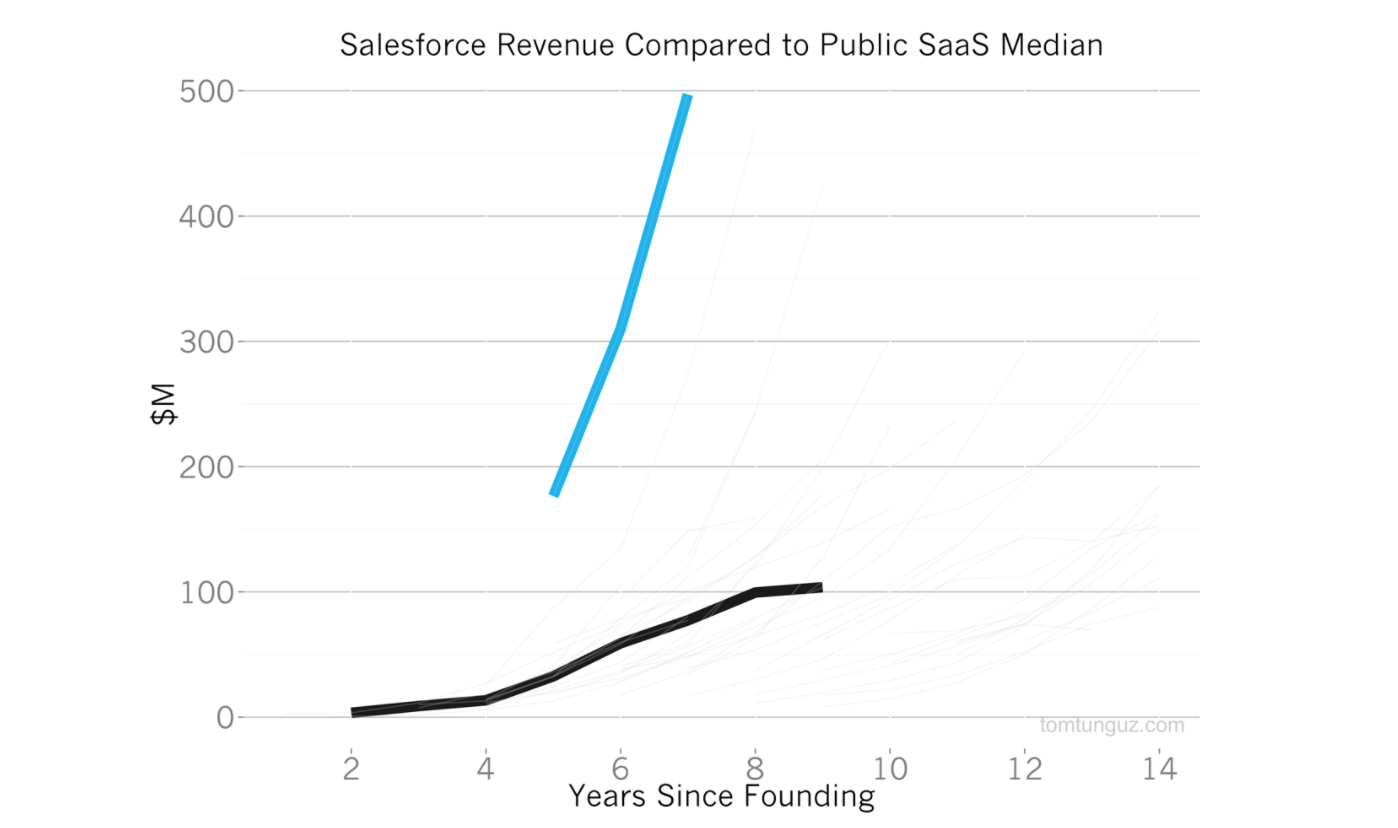
Salesforce revenue growth from 2004-2006.
(▲2004-2006年间Salesforce的营收增长趋势)
现在,Salesforce正在将产品扩展到CRM产品之外,并为客户提供越来越多的服务。CRM只是为Benioff和Salesforce实现下面这个宏大愿景提供了一个入口:一个完全在云上的、没有软件的世界。
Now, the company was expanding beyond a CRM product and helping customers across many services. The CRM had simply provided an entry point to what Benioff and Salesforce had always envisioned: a world without software, entirely on the cloud.
2015年至今:创新,即使作为在市场上已经处于领先地位的在位企业
在Salesforce成立大约15个年头的时候,该公司已经成为了他们开创的行业的领导者。随着他们继续发展,他们会发现有越来越多规模更小、更灵活的创业公司正在进入他们的地盘。他们还会面临其他在位企业的竞争,比如微软和甲骨文,这些在位企业也已经把产品转移到了云端。
By the time Salesforce was around 15 years old, the company had become the incumbent in the industry they pioneered. As they move forward, they’re seeing smaller, nimbler startups enter their turf. They’re also seeing competition from other incumbents, like Microsoft and Oracle, who have now moved their products to the cloud.
为了能够在微软和甲骨文等公司的竞争威胁下生存下来,Salesforce已经改变了自己的战略。它已经不再培育崭露头角的SaaS公司,而是选择与正在威胁Salesforce增长的SaaS公司展开正面交锋。它不再专注于开发那些其他公司同样能开发的工具、资源和社区。相反,他们选择加倍利用最新的技术改进自己的产品,以最直接的方式回应竞争对手。
In order to survive against threats of competition from companies like Microsoft and Oracle, Salesforce has shifted their strategy. Instead of nurturing up-and-coming SaaS companies, they’re competing head-to-head with the ones that threaten Salesforce’s growth. They are no longer primarily focused on creating tools, resources, and communities where others can build. Instead, they’ve doubled down on utilizing the latest technology to improve their own products in direct response to competitors’ moves.
这促使Salesforce进一步在水平和垂直方向进行扩展。Salesforce通过迅速采用和整合最新的技术来改善自己的CRM产品,让产品满足所有不同规模大小的客户的需求。与此同时,他们还需要不断增加新的云服务,以服务更广泛的用例,同时更好地与微软和甲骨文等其他企业级服务商进行竞争。
This has resulted in horizontal and vertical expansion. They’re focused on improving their CRM by quickly adopting and integrating the newest technology and making it available to customers of all sizes. At the same time, they need to keep adding new cloud services to serve a wide breadth of use cases and compete with other enterprise providers, like Microsoft and Oracle.
2015:Salesforce发布了面向小企业的CRM软件SalesforceIQ。随着Salesforce逐渐成长为大企业提供解决方案的提供商,他们为其他公司进入这个领域并占领SMB市场留下了空间。为了解决这个问题,Salesforce在2014年收购了关系智能平台RelateIQ,并将其更名为SalesforceIQ。SalesforceIQ的策略和Salesforce在1999年为CRM产品制定的策略类似:SalesforceIQ一个简单易用的、开箱即用的解决方案,一个团队只需要花几分钟就能免费试用这款产品。
2015: Salesforce released SalesforceIQ, a CRM for small businesses. As Salesforce grew into an enterprise solution, they left room for other companies to come in and capture the SMB market. To counter this, Salesforce acquired the relationship intelligence platform RelateIQ in 2014 and rebranded it as SalesforceIQ. The value prop sounded similar to Salesforce’s original CRM from 1999: an easy-to-use, out-of-the-box solution that a team could start using in minutes on a free trial.

2016:Salesforce以7.5亿美元的架构收购了生产力软件公司Quip,Quip允许多个用户同时协作来创建文档和电子表格。这个生产力工具为Salesforce开辟了一个更广阔的市场空间,并与微软Office和Google Docs直接竞争。
2016: Salesforce acquired Quip, the productivity software company, which allows users to create documents and spreadsheets. This productivity arm provides a huge new breadth of use and competes directly with Microsoft Office and Google Docs.
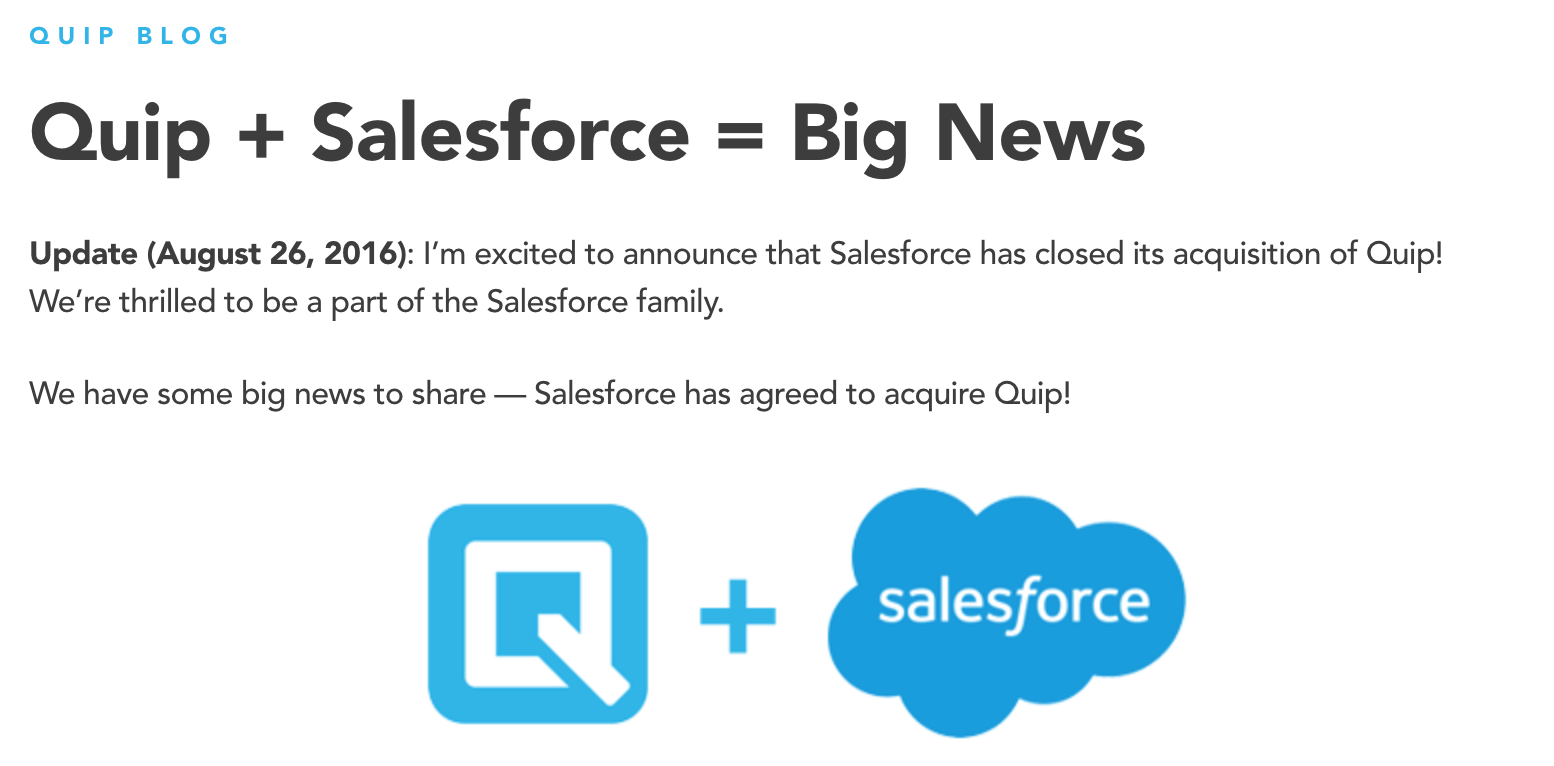
From a 2016 announcement on the Quip blog. Source: Quip
(▲Quip官方博客上发布的Salesforce收购Quip的新闻公告)
同一年,Salesforce收购了电子商务平台Demandware。这帮助他们建立了电子商务云,并开始在Salesforce的产品套件中提供电子商务服务。
In the same year, Salesforce acquired e-commerce platform Demandware. This helped them build out Commerce Cloud and start offering e-commerce services within the Salesforce Suite.
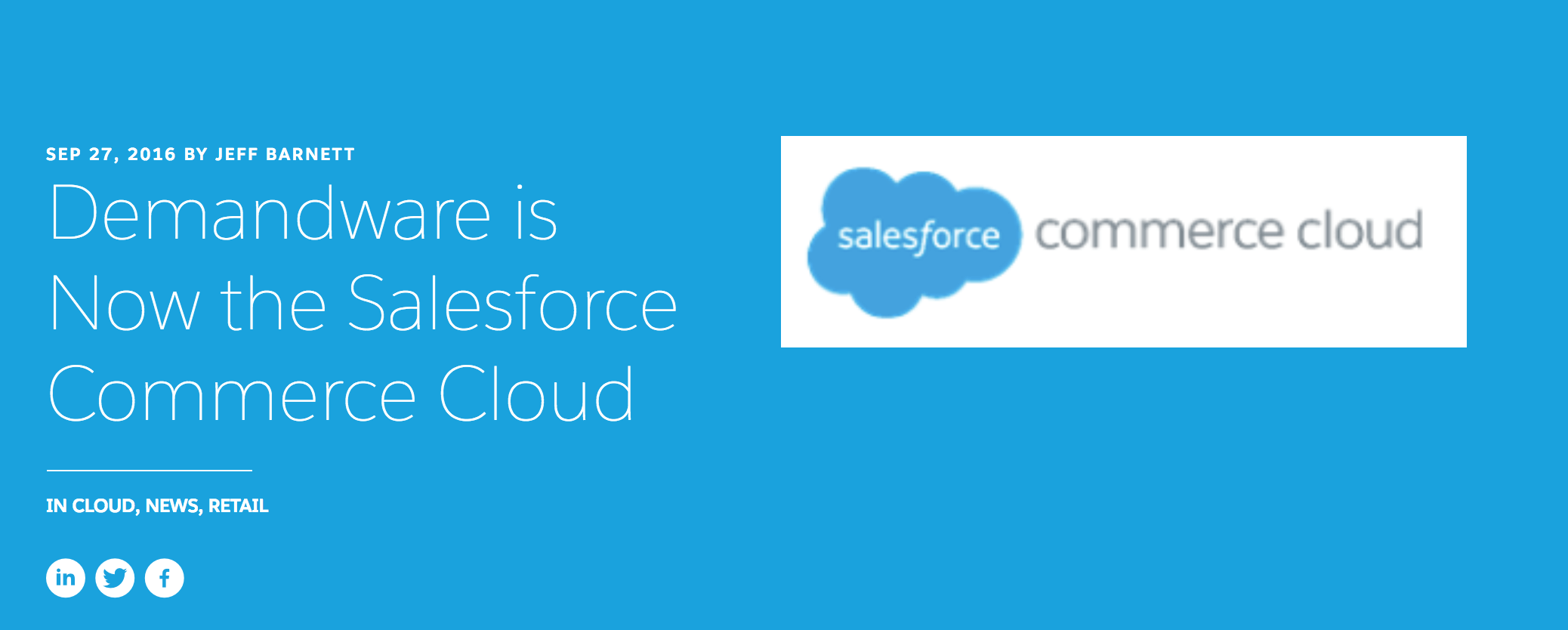
From a 2016 announcement on the Salesforce blog. Source: Salesforce
(▲2016年,Salesforce官方博客上发布的一则收购Demandware消息)
2016年,Salesforce还发布了Salesforce Einstein,将人工智能技术引入到他们目前庞大的产品线中,并允许Force.com用户开发基于人工智能的应用。就在Salesforce发布Salesforce Einstein的同一周,甲骨文公司的自适应智能应用项目也推出了一款针对他们的CRM应用的人工智能应用。几个月后,微软也在自己的Microsoft Dynamics 365 CRM中推出了人工智能功能。
In 2016, Salesforce also released Salesforce Einstein. This brings AI technology to their now-huge range of products, and allows Force.com users to build AI-powered apps. Salesforce announced Einstein in the same week that Oracle released an AI initiative for their CRM with their Adaptive Intelligence Apps. A few months later Microsoft announced AI developments in their CRM with Microsoft Dynamics 365.
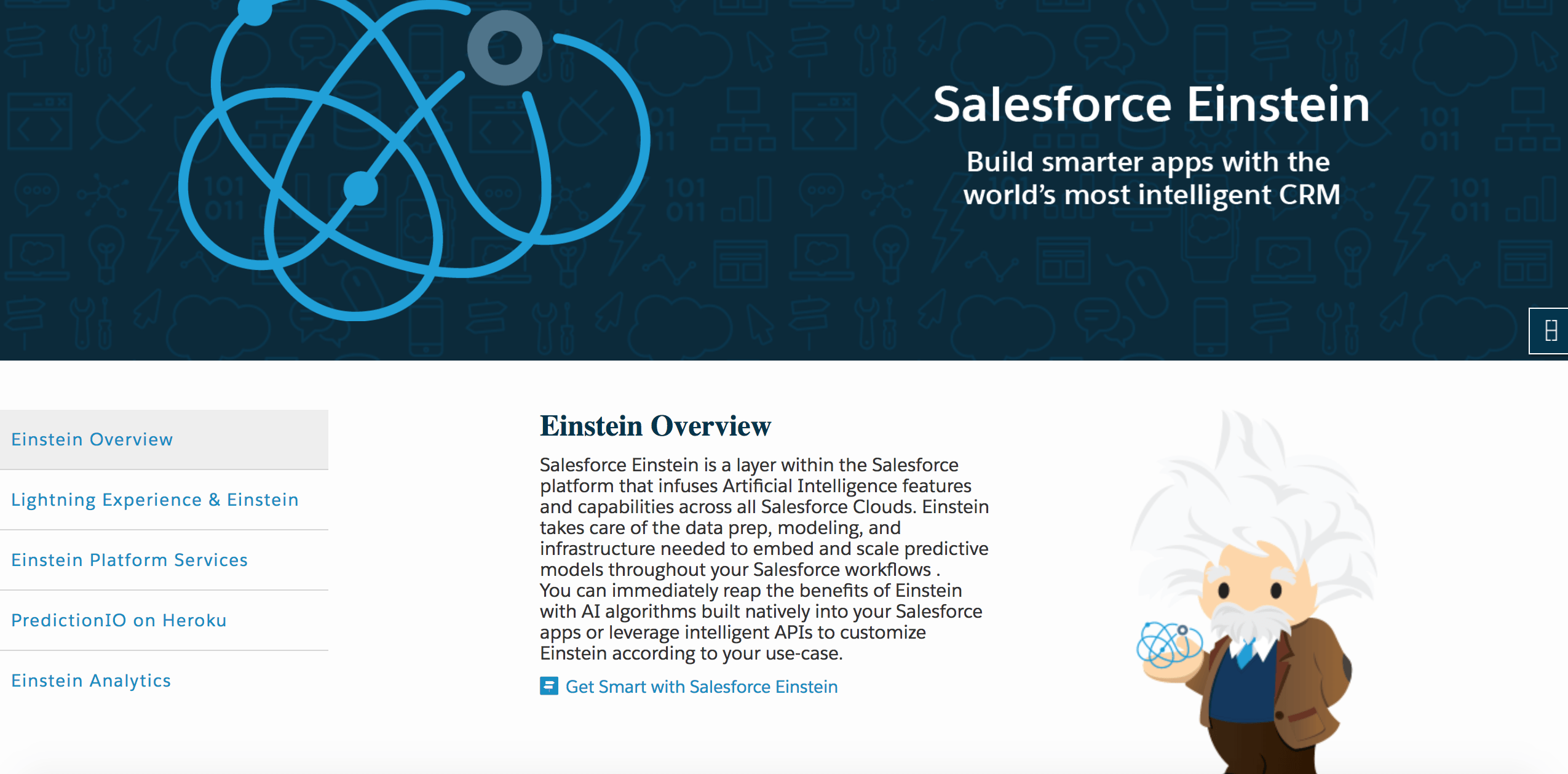
随着Salesforce面临着来自其他CRM和商业软件的竞争,他们不断创造更多的”云“或者提供特定功能的产品,让用户使用Salesforce的产品套件。一旦用户开始使用它的其中一款产品,就更容易用其它产品对该用户进行交叉销售。要想和其它大型云CRM产品竞争,产品的扩张也是一种必须的手段。
As Salesforce faces competition from other CRMs and other business software, they keep creating more “clouds,” or products that served specific functions, to get users into the Salesforce suite. Once they start using one product, it’s easier to cross-sell them on others. The product sprawl is also necessary to compete with other large cloud CRMs.
通过利用人工智能这样的新技术来改进现有产品,并为开发者提供用来开发基于人工智能的应用的工具,Salesforce能够继续让真正强大的技术变得更容易使用。
By improving their existing products with new technology like AI, and giving developers the tools to build AI-powered apps, Salesforce can continue to make really powerful technology easier for people to use.
这并不意味着通过引进人工智能这样的新技术就能够足以让Salesforce保持竞争力,尤其在其他公司也在大力将人工智能技术整合进他们的产品中时更是如此。不过,通过将自己开发的产品与公司收购的其它云产品进行结合,Salesforce可以为用户提供更多的产品种类,Salesforce可以继续强化自己的平台和产品套件属性,这一平台和套件的发展规模已经远远超出了一个单一的CRM的规模。
This doesn’t mean that new technology like AI is enough to keep Salesforce competitive—especially since other companies are also making strong pushes to incorporate AI. But in combination with their other cloud acquisitions that allow them to provide more product offerings to users, Salesforce can continue to strengthen itself as a platform and suite that has grown much, much larger than just a CRM.
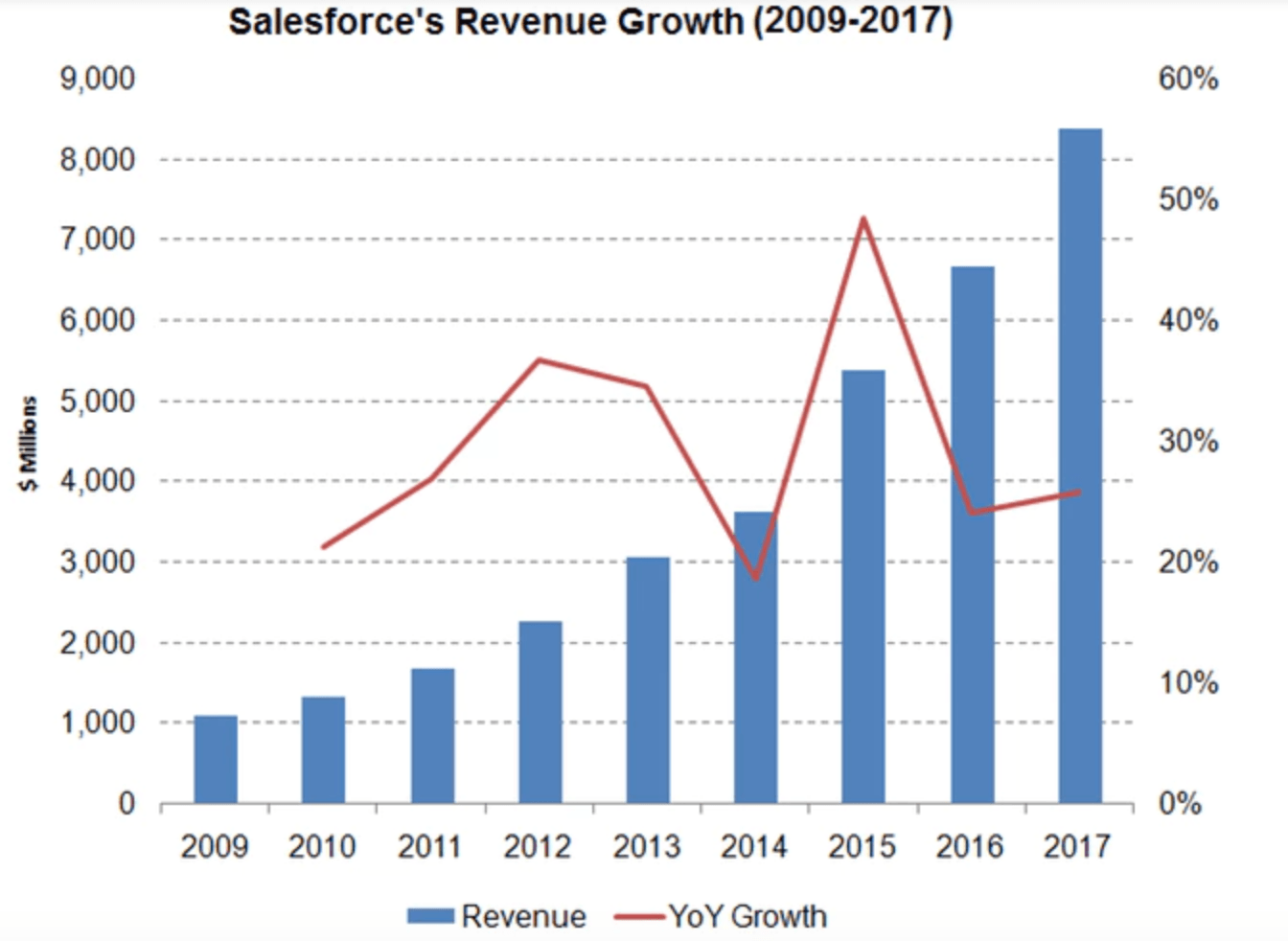
Salesforce’s revenue growth and growth rate. As of 2017, their revenue for the year is exceeding $8 billion and their growth rate is just under 30% YoY.
(▲Salesforce的营收增长和增长率。2017年,他们的营收有望超过80亿美元,同比增长率接近30%。)
Salesforce正面临来自四面八方的威胁,但是它依然在全速前进。
The company is facing threats from many sides, but they’re still pushing forward.
Salesforce的未来将走向何方?
Where Salesforce can go from here
Salesforce目前是云SaS服务领域的领先平台。这意味着如果稍有不慎,他们就会损失巨大。尽管他们在SaaS生态系统上投入了大量资金,而且在很多方面帮助了其他公司成长,但是它也为其他公司进入自己所在的市场创造了空间。其它公司通过将自己的传统产品搬到云端,并通过提供更轻便、更廉价的解决方案的方式来吞噬Salesforce自己的客户群。
Salesforce is now the premier cloud SaaS incumbent. That means they have a lot to lose. Though they’ve invested heavily in the SaaS ecosystem—and in many ways helped other companies grow—they’ve also created room for other companies to move their legacy products to the cloud and left openings for smaller and cheaper solutions to chip away at their customer base.
不过,因为Salesforce已经成长为一个全方位的云服务提供商,而不仅仅是一家CRM商,它未来还有很大的扩张发展空间。Salesforce可以:
But because Salesforce has grown into a multipurpose cloud service provider—rather than just an enterprise CRM—they still have a lot of room to expand. They can:
(1)在他们的云产品套件中提供网络服务。一系列的收购已经帮助Salesforce扩展到很多全新的领域。但Salesforce尚未在网络领域进行大规模扩张。去年,在收购LinkedIn的竞争中,Salesforce输给了微软。通过他们自己的Dreamforce大会和AppExchange、force.com平台,Salesforce已经为一个拥有强大社区属性的网络奠定了基础。在内部打造一个自己的网络可以帮助他们在销售、营销和协作云之上拥有数据和网络层。
* Provide network services within their suite of cloud products. Acquisitions have helped Salesforce expand into completely new categories. But Salesforce has yet to make a significant expansion into a network—they lost a bid to acquire LinkedIn last year to Microsoft. They’ve already laid the foundation for a network with strong communities through their Dreamforce Conferences and their AppExchange and Force.com platform. Creating a network within could help them own the data and network layer above their sales, marketing, and collaboration clouds.
(2)为客户提供更好的人工智能。Salesforce已经将人工智能整合到自己的很多产品中了。这在一定程度上要归功于与IBM的合作,通过将Salesforce Einstein和IBM的Watson进行结合,让客户可以增大他们在Salesforce里获得的数据。但是与更多的数据随之而来的是日益增加的复杂性,很多人已经认为Salesforce太复杂了。与此同时,其它公司的很多产品都专注于产品的易用性。Salesforce可以利用人工智能让用户更方便地从他们的产品中获取他们需要的信息,特别是Salesforce已经有了一个名为Optimus Prime的内部工具,用户可以用这个工具来组织和清理数据。
* Bring better AI utility to their customers. Salesforce is already in the process of incorporating AI into many of its products. This is in part due to a 2017 partnership with IBM to combine Einstein and Watson, to allow customers to augment their data that’s already in Salesforce. But with more data comes more complexity, and a lot of people already think Salesforce is too complex. Meanwhile, many new products are focused on ease of use. Salesforce can use AI to make it easier for users to get the information they need from their products, especially since they already have an internal tool called Optimus Prime to organize and clean data. This would be a big opportunity to add services around all of the data that users already have in Salesforce.
(3)专注于国际市场的扩张。一开始的时候,Salesforce主要通过专注于美国市场来实现增长的。如今,它有机会通过向海外扩张的方式来实现更快的增长。就在去年,Salesforce与AWS达成了合作协议,扩大双方的合作范围。合作之后,Salesforce在拥有数据主权法律的国家已经不需要自己再从零开始建立数据中心了。然而在需要的情况下,Salesforce依然会建立自己的数据中心。今年早些时候,它在日本建立了自己的第二个数据中心,以应对亚太地区日益增长的产品使用量。在业务持续增长的国际地区,建立自己的数据中心能够让Salesforce拥有更大的优势,让他们能够更好地服务更多地区的用户,而不用依赖向亚马逊和微软等公司租赁资源。
* Focus on international markets. Salesforce grew by focusing on the U.S., but they now have an opportunity to grow more aggressively by expanding overseas. Just last year, they made a deal with AWS to expand their partnership; now, Salesforce doesn’t have to build data centers from scratch in countries with data sovereignty laws. However, they are still building their own data centers where it makes sense; they built their second data center in Japan earlier this year in response to increased usage across the Asia-Pacific region. In international regions that are continuing to grow, building their own data centers gives Salesforce more of an advantage, allowing them to better service more geographic regions without relying on rented resources from companies like Amazon and Microsoft.
Salesforce能否在云服务领域持续占据统治地位将取决于他们能否继续在产品上进行创新,并提供更多的云解决方案。他们在过去的18年时间里就是通过这个方法获得成功的。
Salesforce’s continued reign in cloud SaaS will depend on how well they can keep innovating on their products and offering more as a cloud solution. This has been their playbook and it’s what has brought users the most benefit and success over the last 18 years.
3 key lessons we can learn from Salesforce
Salesforce带给我们的三条关键经验
Salesforce将整个软件行业完全转移到云端是具有革命性意义的。但是,如果他们向用户销售的只是一款非常蹩脚的产品的话,用户依然是不会为它买账的,也不会关心它是否将软件搬到云端这件事。
The way that Salesforce completely moved the entire software industry to the cloud was revolutionary. But users never would have paid them any attention or cared about their cloud movement if they’d been selling a crappy product.
Salesforce开发了一个CRM工具,并将其放在云端,这样他们就可以让用户对云产品感到兴奋。然后,他们利用自己在云计算行业的领导者地位开发出用户需要的更多更好的产品,从而推动了公司业务的持续增长。如果你正在开发自己的产品,你可以从Salesforce的发展历程中学到很多东西。
Salesforce created a CRM and put it in the cloud so that they could get users excited about cloud products. Then, they used their position as the cloud leader to build out more (and better) products that users wanted, and that fueled their own growth. If you’re building your own product, there are a lot of lessons you can learn from Salesforce’s journey.
1. 你如何改进目前的一个工具或流程?
1. How can you improve a current tool or process?
Salesforce的云端CRM和他们发起的“no software”的活动都完全基于这样一个想法:本地部署的软件太难安装和更新升级了,用户需要一款更简单易用的产品。
Salesforce’s cloud CRM and their “no software” campaign were based entirely on the idea that on-premise software was too hard to install and upgrade, and that users would want something easier.
要想打造一款用户真正会关注的产品,你必须找到一个比当前的解决方案更好的解决方案来解决一个用户面临的问题。下面是如何找到减少产品摩擦的方法:
To create a product that people will pay attention to, you have to solve a problem better than the current solutions. Here’s how you can find ways to reduce friction in your products:
- 一步一步地分解你的客户体验。Amazon Music的产品负责人Kintan Brahbhatt相信,产品中实际存在的摩擦点比打造这款产品的人意识到的要多得多。他建议产品经理“列出一个客户使用你的产品完成一个任务所需要做的所有决定的列表,然而重新审视列表中的每一个问题。”
- * Break down your customer’s experience step-by-step. Product Leader at Amazon Music Kintan Brahbhatt believes there are a lot more friction points in products than the people building products realize. He suggests that product managers “make a list of all decisions a customer needs to make in order to complete a task in your product. Then question each one.”
- 通过评估功能与产品的相关性,来对功能进行删减。你开发出来的有些功能特性可能并没有达到所期望的效用或受欢迎程度。对所有功能进行重新评估,并移除那些增加了用户使用难度的功能。我建议使用Des Traynor的评估框架来评估是否删除一项功能,他建议你问自己这样的问题:“如果你当时就知道现在你知道的这些事情,你是否依然还会:
* 开发这个功能?
* 推出这个集成?
* 选择这个架构?
* 设计这样的屏幕?
- Prune features by evaluating how relevant they are to your product now. Some features that you’ve built probably didn’t turn out to have the utility or popularity you anticipated. It’s important to evaluate and remove any features that add more difficulty for your users—even if you are attached to them. I recommend Des Traynor’s framework for evaluating features to cut: he suggests asking yourself, “If you knew then what you know now, would you still have…”
* built that feature?
* shipped that integration?
* chose that architecture?
* designed that screen?
2. 你们公司的品牌是什么,这个品牌是如何影响公司的产品的?
2. What is your company’s brand, and how does that impact your products?
Salesforce的重点是让产品变得更简单,并以一个创新者的身份自居,在他们做产品决策的时候都会围绕这一点来进行。一个定义良好的品牌可以让你在产品开发中保持专注。
Salesforce’s emphasis on making things easier and on being seen as an innovator informed their product decisions as they grew. A well-defined brand can help keep your product development focused.
正如Salesforce在其广泛的产品套件中所展示的那样,这并不会限制公司的选择和发展空间。一个定义良好的品牌能够帮助你从竞争中脱颖而出,它能让客户知道他们该对你的公司有什么样的期待。你可以通过下面这些方法来识别和进一步定义你的品牌:
As Salesforce demonstrates with its broad suite of products, this doesn’t have to be restrictive or limiting. However, a well-defined brand will help you stand out from competition, and it tells users what they can expect from your company. Here’s how to recognize and further define your brand:
* 给客户发送一份NPS(净推荐值)调查问卷,并关注定性答案。除了要求用户在问卷中进行打分外,在问卷中留下一个开放式的空间,让用户针对你产品的品牌体验上留下书面反馈。然后,你可以使用一个文字云生成器来组织你的调研结果。
* Send out an NPS survey and focus on qualitative answers. In addition to asking users to provide a numerical score, leave an open-ended field for users to leave written feedback on their experience with your brand. You can then organize your survey responses with a word cloud generator, like I did here with Slack.
* 创建一个用于对价值进行分类的电子表格。在电子表格中,将你的产品的每一个功能与它对用户的价值和你的品牌的价值联系起来。通过这种方式来可视化你的产品,你可以从中了解你的产品是否与你你想要向客户传达的主要营销信息相一致。
* Create a spreadsheet to categorize value. In the spreadsheet, connect each of your product offerings to the value for users, as well as the value for your brand. Visualizing your product offerings like this will allow you to see how your product is— or is not—connecting to the main marketing message you want to send to customers.
3. 随着竞争的加剧,你如何使自己变得更有价值?
3. How can you make yourself more valuable as competition increases?
正如知名风险投资人Tom Tunguz所说的那样,SaaS公司的三个持久性竞争优势分别是网络效应、数据网络效应和生态系统的打造。Salesforce创造了一个生态系统,因为在当时新兴的SaaS市场中,生态系统是最适合Salesforce的选择。
As Tom Tunguz explains, three enduring competitive advantages for SaaS companies are network effects, data network effects, and ecosystem creation. Salesforce created an ecosystem because that was the best fit for them in the emerging SaaS market at the time.
根据你公司的具体情况,有很多方法可以让你在竞争中建立优势。你可以通过下面这些方法进行评估:
Depending on your company, there are ways for you to build in competitive advantages. Here’s how to evaluate:
* 了解用户为什么会选择竞争对手的产品。在论坛上发布这个问题来问真实的用户:“为什么人们会使用X这款产品?” 一定要选择一款与你的产品有竞争力的产品进行调研。问这个问题还能够让你了解用户从竞品中得不到什么。这有助于你开拓一个独特的利基市场,为用户提供一些他们还没有得到的有独特价值的东西。
* Understand why users would choose a competitor. Post a question on a forum to ask real users, “Why are people using [X] product?” Choose a product that is competitive to your product. Asking this question can also show you what users are not getting from a competing product. This helps you to carve out a distinct niche that gives users something they’re not already getting, and is valuable in a unique way.
* 通过发布免费的工具来让用户亲身体验你的产品的实用性和独特价值。在一个竞争非常激烈的环境中,很多时候客户可能无法立即理解你的产品的价值,仅仅让他们试用你的产品已经非常困难了。免费工具能够让更广泛的用户有机会接触你的产品,让用户能够亲自探索和体验你的产品的价值。
* Release free tools to let people see for themselves how useful your product is. In a very competitive environment where there’s a lot to gain or where customers may not immediately understand the value of your product, merely getting them to try it can be difficult. Free tools, or free tiers like Salesforce’s very first CRM, can help get your product in front of a wide audience and allow users to explore the value of your product for themselves.
在《 Behind the Cloud》这本书中,Benioff这样写道:“一个单一的想法只是一种策略,但如果它能够以多种不同的方式来执行,它就会变成一个伟大的战略。”
In his book Behind the Cloud, Benioff wrote, “One idea alone is a tactic, but if it can be executed a number of different ways, it becomes a great strategy.”
我经常会说,没有所谓的捷径可走。增长黑客那一套只能帮你获得短期效果,它无法帮助Salesforce取得现在取得的成功。为此,你需要一个愿景和一连串的方法来让愿景成为现实。
I always like to say that there are no shortcuts. Growth hacks and pickaxes work in the short term, but they don’t set you up for the kind of growth that Salesforce has achieved. For that, you need a vision and a never-ending list of ways to make that vision a reality.
如果他们只是一直销售CRM产品的话,那么Salesforce就不可能取得今天的成绩。CRM只是一个跳板,让Salesforce能够顺利跳入云市场。但他们成功的原因是他们不断寻找新的方法来执行云产品战略并持续传播他们的愿景。
There’s no way that Salesforce would have gotten to where it is today if they’d just peddled a CRM. Their CRM was a crowbar that let them pry their way into the cloud space. But what made them successful was that they kept finding new ways to execute on cloud products and evangelize their vision.
Salesforce在1999年开始增长并一路高歌猛进时候,它为SaaS公司设置了一个高门槛。现在,它需要比自己的前任做得更出色,否则就有可能被超越。如果Salesforce继续寻找方法来执行从1999年就开始执行的战略的话,它将继续成为SaaS行业最关键玩家之一。
Salesforce certainly set a high bar for SaaS companies in 1999 when it started growing and didn’t stop. Now, they need to live up to their own precedent, or risk being overtaken. If they keep finding new ways to execute on their strategy from 1999, they’ll continue to be one of the key players in the SaaS industry.
创业者是富有远见的梦想家,他们能看到一个更美好的未来,并坚信能够将梦想变成现实。创业者所面临的挑战是要不断思考自己的下一步该怎么走。下一次的颠覆会是什么,下一次颠覆将会如何重塑公司?创业精神的核心就是敢于冒险的精神,同时敢于对“接下来会发生什么”做出大胆的假设。Benioff是一个富有持续远见的人,他的雄心没有停留在对Salesforce产品的最初设想上。
他一直在思考Salesforce的演变:从单一应用到一套应用,再到一个快速应用开发PaaS平台,从企业协作工具到一个应用程序容器和数据库提供商。Salesforce发展的每个阶段都受到竞争对手和相邻领域公司的发展影响。公司的产品策略也在顺应着潮流,从移动云计算到社交网络,再到大数据。在这个过程中,Salesforce 也学到了通过收购公司的方式来获取有助于实现公司愿景的核心技术。
对于软件的未来,Benioff经常会做出比较大胆的预测,并把将预测变为现实的艰巨任务交给自己的团队去完成。他自己非常喜欢下面这句话:“对于1年内能实现什么,大家普遍都预估过高,但对于10年内能实现什么,大家往往又太过低估。”想想明天能带来什么,对于公司10年内能取得什么成就要做出大胆的预测。然后跳上冲浪板,脚踩浪潮,勇往直前。
参考:
How Salesforce Built a $13 Billion Empire from a CRM [The Full History]














